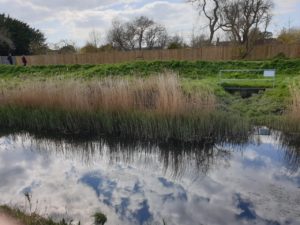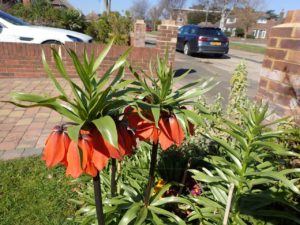We seem to be moving out of lockdown into ‘alertness’, which means more freedom to go out – keeping the 2 metres ‘social distance’, or wearing masks where we cannot do that, and that more shops will be opening soon, beginning with Garden Centres. I know that many Conservation Group members have been helping their friends and neighbours with shopping and other essentials, and it may be necessary to keep this up for a few more weeks at least. As before, if you know of anyone who needs help but not getting it please let me know – EdMiller43@msn.com
Woodland Spring Flowers – 13th April
If you are lucky enough to be near woodland or can walk along hedgerows, April is the perfect time to identify woodland flowers. Most flower early before they are shaded by the tree canopy above. The following is a list of 20 found in Patching Woods. See how many you can find, some may even be in your garden:-
Wood anemone (Anemone nemorosa) white/pink flowers
Primrose (Primula vulgaris) pale yellow flowers, large crinkly leaves
Bluebell (Endymion non-scriptus) blue, with cream anthers, long thin leaves
Dog’s Mercury (Mercurialis perennis) tiny, inconspicuous flowers
Violet (Viola species) blue/purple flowers, heart-shaped leaves
White Dead-nettle (Lamium album) white flowers, nettle-like leaves
Garlic Mustard (Alliaria petiolata) white flowers, other name Jack-by-the-Hedge
Ladies Smock (Cardamine pratensis) pale pink flowers, other name Cuckoo Flower
Greater Stitchwort (Stellaria holostea) white flowers, quite tall
Red Campion (Silene dioica) red flowers, tall
Lords-and-Ladies (Arum maculatum) purple or yellow spadix with green spathe (hood)
Wild Garlic (Allium ursinum) white flowers, strong-smelling, edible
Ground Ivy (Glechoma hederacea) violet/blue flowers, leaves kidney-shaped
Red Dead-nettle (Lamium purpureum) pink/purple flowers, square stems
Wood spurge (Euphorbia amygdaloides) tall, tiny flowers in yellow/green, cup-like bracts
Wood sorrel (Oxalis acetosella) white flowers, trefoil leaves, in ancient woods
Lesser Celandine (Ficaria verna) glossy yellow flowers, heart-shaped leaves
Goldilocks Buttercup (Ranunculus auricomus) small yellow variable petals, divided leaves
Early Purple Orchid (Orchis mascula) purple flowers in spike, black spots on leaves
Foxglove (Digitalis purpurea) very tall with purple flowers, large soft leaves
To help you identify the flowers, you can take photos on your phone or camera and then use the internet or an identification book to help you. I can recommend The Wild Flowers of Britain and Ireland by Blamey, Fitter and Fitter, second edition, 2013. Please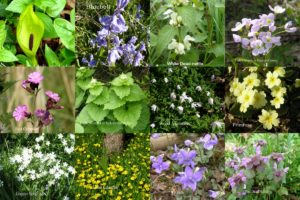 do not pick the flowers. If you make your own list in a note book, record when and where you find the flowers and then you will build up a useful plant list.
do not pick the flowers. If you make your own list in a note book, record when and where you find the flowers and then you will build up a useful plant list.
A collage of 12 of these woodland flowers may help your identification.
Nature Notes:
During these unparalleled times it is reassuring to observe that nature continues to thrive all around us.
Please see our Nature Notes page for up to date observations and suggestions from the Group’s wildlife expert, Tricia Hall.
Butterfly Observations – 7th April
The warm weather is beginning to bring out the butterflies. Look out for the following in your garden or on your daily walk. These are common April butterflies: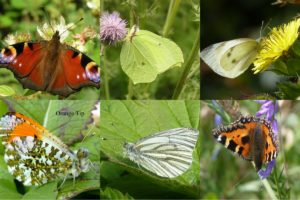
Peacock, often a pair doing a dance, spiralling into the air.
Small Tortoiseshell, often sunning itself on the ground.
Orange Tip, small, the female has grey rather than orange tips.
Small White, the first of the ‘cabbage whites’ to emerge.
Green-veined White, like Small White but underside has grey/green veins.
Brimstone, yellow, distinctive shape, female very pale yellow.
These 6 butterflies are shown on the collage to help you. See if you can tick off all 6 by the end of the month. Have you started your plant list yet? Now you can make a list of butterflies as well! Let me know if you record all six. There are other species as well which you may see. You could try and photograph them if they settle.
Look out for other insects in your garden. Have you seen a Bee Fly? They are very common this year.
Two Cheerful Photographs of Ferring
A Member’s Observations – 2nd April
A member writes: It has been glorious the last few days on Highdown, with views from the Isle of Wight to the Windfarm and Brighton. On a very clear day it is possible to see Portsmouth’s Spinnaker Tower but only at a height from horseback, The Cathedral is easier to pick out. The mass exercising of dogs has ceased and most walkers are behaving. Skylarks are common both high up and when canoodling on the ground. There are several rafts of molehills. On the chalk slopes crows and jackdaws abound with isolated pied wagtails and a redwing in flight. A few goldfinches are around and we are waiting for swallows to return to their old nests in the stables. The badgers’ set along the ridge to Angmering has collapsed and they may have transferred to a second old set near the bottom of Hangleton Lane. Blackthorn for sloe berries and gin later is brilliant. Cow parsley abounds, the first time for years that it has been apparent throughout a winter.
If you walk up the lane, the first field on the right houses two huge hunters, Captain is in retirement and Duke is too difficult to ride. Please don’t feed them, some have tried as shown by carrots thrown into the field.’
So, all nature looks good and as it should be. However, there is something wrong down below; fewer trains, much less traffic on the 259, Honda and Peugeot are sleeping, no jets powering down approaching Gatwick.
……And David Bettiss points us to the web camera on the Peregrine’s nest on the roof of Chichester Cathedral: chichesterperegrines.co.uk
Members’ Observations – 1st April 2020
A member writes from Hangleton Lane: ‘Wild life revives: we have seen here apart from the resident blue and coal tits doves and pigeons, a fox, a moorhen, three ducks, a heron, a pheasant, and one small rabbit .What a difference it makes when Yeoman’s shuts down!’
Another, writes from off Langbury Lane, ‘We have the usual bird feeders, with anti-squirrel cages, but also a stick-on feeder for the window. This allows the less dexterous and bigger birds to obtain food just by landing on the open feeding area. Now they are all busily nesting, all the feeders are getting hammered and will get even more so once the chicks hatch. Now we all have more time at home, we can spend some of it allowing our feathered friends to entertain us. Seeing 15 starlings all challenging each other to get to the window feeder, I seriously wonder if any of them get anything. The savvy blackbirds wait underneath and pick up all the dropped seeds, etc. We have found the suet pellets with fruit or worm bits are scoffed by nearly all with sunflower hearts being almost universally rejected. The shallow water bowls nearly are also heavily used for bathing and drinking so it is a regular daily job to keep everything in order. The window bird feeders can be bought on Amazon as indeed can a huge variety of bird food and could provide an worthwhile diversion for people who are stuck at home, perhaps on their own.
The 10 Wild Flower Challenge – 3rd April
Being confined to Ferring, this is the perfect opportunity to get to know your local wild flowers. 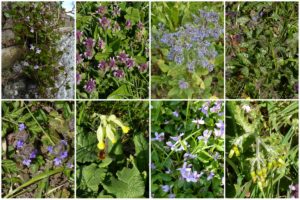 Your challenge is to go and identify the 10 flowers I have listed below. Many are what you may call weeds but some can look lovely in a wild place in your garden. I have suggested where you may find them:
Your challenge is to go and identify the 10 flowers I have listed below. Many are what you may call weeds but some can look lovely in a wild place in your garden. I have suggested where you may find them:
Little Paddocks Ground Ivy, blue flowers, Lungwort, pink/purple flowers, Borage, blue flowers, lots on wild flower bed, Little Twitten White Dead-nettle, white flowers, everywhere
Red Dead-nettle, in your garden?
Violets, blue, Highdown in chalk pit, Little Paddocks
Cowslips, yellow, in meadow below Highdown Gardens
Ivy-leaved Toadflax, purple, on walls
Shepherd’s Purse, tiny white flowers, in your garden?
Groundsel, tiny yellow flowers, in your garden?
My suggestion is that you make a list of these plants in a note book. See if you can find each one, then make columns for the date, where found and notes on identity. You can then build up your own plant list. Let me know if you do this!
The pictures are to help you but I have not named them!
This weekend it will get warmer and the winds are coming round to the south so look out for migrant birds arriving. There may be more butterflies too. Another list?
Observations and Suggestions 28th March
If you have a nest box or any nest in your garden, this might be a good time to keep a regular watch and record dates of bringing in nesting materials, food, and removal of faecal sacs and later fledgling. When baby birds are being fed it is amazing to see how frequently the adults come to the nest. You can count how many times in say 10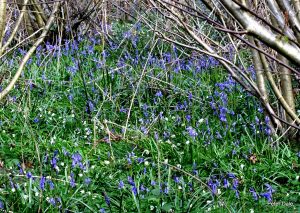 minutes. If you know where the nest boxes are around the village you could also record activity there.
minutes. If you know where the nest boxes are around the village you could also record activity there.
Keep an eye on the sky. There are many reports of buzzards (over the Rife, from David Bettiss) and kites and a pair of buzzard are probably breeding again on the west side of the East Preston/Ferring gap.
Bird song is brilliant at the moment. Check you can identify the song of robin and blackbird. You can see them singing to confirm identity. Try to learn one song at a time. Small migrants are starting to arrive: listen out for the first of the warblers, the chiffchaff. This is the easiest song to identify because all they do is go ‘chiff’ and ‘chaff’, like a pendulum. Don’t confuse with a great tit which goes ‘teach-er, teach-er”.
Graham has reported butterflies in his garden: a comma, peacock and brimstone Brimstones are pale yellow, males brighter than females. I have seen small tortoiseshell and red admiral. Any records of small tortoiseshell would be useful.
Graham Tuppen has evidence of hedgehogs in his garden and he says that bluebells are just beginning to come out in Clapham Woods together with the lovely wood anemones.
Being somewhat confined, might be a good time to start doing some daily records of observations in your garden. You might be surprised at what turns up! A note book and identification books are all you need whilst sitting in the sun.
Presentation to Chestnut Tree House Children’s Hospice
The Group’s Chairman David Bettiss, accompanied by Tricia Hall, recently visited the local Chestnut Tree House Children’s Hospice to present a cheque for £600 raised by the sale of Tricia’s beautifully designed  Christmas Cards. The cards have been sold on behalf of Ferring Conservation Group exclusively to raise funds for the Hospice. The Group are delighted to have supported Chestnut Tree House over the last 8 years with many thousands of pounds raised in this way.
Christmas Cards. The cards have been sold on behalf of Ferring Conservation Group exclusively to raise funds for the Hospice. The Group are delighted to have supported Chestnut Tree House over the last 8 years with many thousands of pounds raised in this way.

